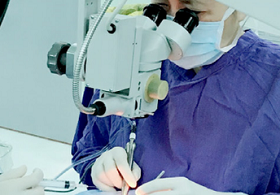In the United States, cataract surgery has a high success rate and is among the most frequently performed operations. More than 3 million Americans benefit from cataract surgery each year. The pricey antibiotic and steroidal eye drops that patients must use following surgery are one of the most often voiced concerns about cataract surgery. To keep the eye from getting infected and to reduce swelling, the drops must be used several times a day at regular times.
The exciting new development in cataract surgery is known as dropless cataract surgery. Dropless cataract surgery makes it possible for your eye surgeon to inject antibiotic and anti-inflammatory medication directly into the eye during surgery, whereas standard cataract surgery requires patients to use post-operative eye drops following the procedure.
What are the pros of Dropless cataract surgery?
Dropless surgery minimizes the risk of infection three times and lessens the amount of eye discomfort that occurs following surgery. After surgery, the patient doesn't need to utilize eye drops because the drug was given to the eye during the procedure. There is no longer any need to be concerned about applying the appropriate eye drops.

Dropless cataract surgery provides the following benefits
- Eliminates the requirement for the use of drops (post-op care)
- You will save between $150 to $300 on eye drops prescribed by your eye surgeon.
- Reduced risk of infection and retinal swelling
- Simplifies the postoperative regimen
What are the cons of Dropless cataract surgery?
Though dropless cataract surgery eliminates the need for drops, however, a recent study found that up to 20% of individuals still need drops. Immediately following surgery, there may be floaters or cloudiness as a side effect. This side effect will go away as soon as the drug is absorbed into the eye. Some people who have diabetes or specific retinal problems must utilize one eye drop both before and after surgery.
FAQ's
Is dropless cataract surgery safe?
According to the findings of numerous studies, the dropless technique is not only risk-free but also incredibly efficient. Data shows that there very low number of complications associated with dropless cataract surgery. Furthermore, it is cost savvy and more convenient than traditional cataract surgery.
What is trimoxi dropless cataract surgery?
Trimoxi is a significant advancement in decreasing patient costs, inconveniences, and post-operative problems. Trimoxi is an antibiotic (moxifloxacin) and steroid (triamcinolone) combination that is injected into the vitreous after the IOL has been implanted.
Does medicare cover dropless cataract surgery?
It is important to understand that Medicare does not cover routine eye exams; however, cataract surgery is covered under Original Medicare and Medicare Advantage. Surgery that is performed with either lasers or conventional or using any other surgical method will be covered.
The entire cost of cataract surgery is typically covered by Medicare Advantage plans. Many surgeons, hospitals, and surgical centers are not enrolled with most of the Advantage plans." For this, it is essential to verify that your insurance will be approved prior to scheduling the treatment.
What are the potential downsides or problems of dropless cataract surgery?
A recent study indicated that up to 20% of people still require drops despite dropless cataract surgery eliminating the need for drops. As a side effect, there could be floaters or cloudiness just after surgery. As soon as the medication is absorbed into the eye, this negative effect will disappear. There are some patients who need to use one eye drop both before and after surgery because they have diabetes or a specific retinal condition.







0 Comments
For comments please reply here.......